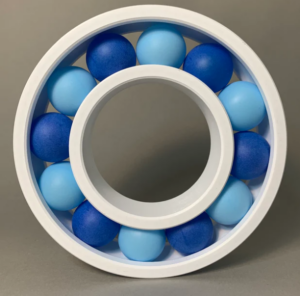Some people think bearings are boring. Those people are wrong. Sure, you might not live, breathe, and eat them like we do at Alpine Bearing, but we hope everyone can still share our love for these components. Bearings are precise, reliable, and beautifully engineered. Yet they can also be fun, weird, and even magical. Read on for facts about bearings in strange places, at astounding sizes and temperatures, and throughout history.
Bearings in surprising locations
- Bearings help buildings survive earthquakes. The international terminal at Istanbul’s Sabiha Gökçen Airport is the largest building in the world to sit on seismic base isolators. Seismic base isolators buffer the terminal from earthquakes.
- Great industrial design is truly an art. A self-aligning ball bearing designed by SKF’s Sven Wingquist is part of the Museum of Modern Art’s collection. MoMA founding director Alfred Barr Jr. included it in the 1934 exhibition “Machine Art”. The museum says, “The ball bearing is illustrative of Barr’s overarching idea: even machines could be appreciated for their beauty, which comes from the purity of their geometric forms.”
- Steel balls…on a delicious piece of salmon? Bon Appétit media personality and chef Brad Leone uses bearing balls as cooking weights. “We use them for pie weights, but they’re great for gravlax weights,” he says.
Big, small, smooth bearings
- A lifting, drilling, and energy company manufactures the world’s largest ball bearings. Huisman makes gargantuan bearings for the pivoting system on its tub cranes. The company’s biggest bearings are 30 meters in diameter – so big that two parallel-parked city buses could fit inside without touching the inner ring. The bearings reduce the weight of Huisman’s cranes, which can lift 10,000 metric tons.
- Minebea Co., Ltd., a Japanese bearing manufacturer, won a Guinness World Record for the world’s smallest commercially available steel ball bearing. The award-winning mini-bearing is 1.5mm in diameter. Its internal diameter measures just 0.5mm. The bearing supports tiny axles in the tourbillon mechanism of high-end mechanical watches, a role traditionally played by pivots made of jewels. Bonus fact: Alpine is an authorized distributor of bearings from NHBB and NMBTC Bearings, two Minebea Group companies. Read more about our relationship with them here.
Hot bearings
- Flywheel energy storage systems spin faster than 50,000 revolutions per minute. The extreme speed can make normal bearings melt or explode. To get around this, engineers choose mag-lev bearings. These bearings use a magnetic field, rather than balls or rollers, to reduce friction.
- If you’ve ever disassembled a failed high-RPM pump and found hollow, broken bearing balls, it wasn’t because the balls were faulty, according to a training manager from SKF. Even the highest-quality balls naturally contain oxygen inclusions. As a failing bearing grows hotter and hotter (up to 350°C!), those inclusions expand. They rub the ball against the raceway until the inclusion reaches the surface and bursts. The result is a hollow ball with an opening in it. That’s why we recommend checking bearings regularly to be sure they’re still serviceable, especially in harsh environments.
Ball bearing origins and history
- People have been using roller and ball bearings for millennia. Celtic carts from about 2,000 years ago had bronze bearings with wooden rollers. A Roman ship from the 1st century AD had a platform that rotated on a surprisingly advanced ball bearing. The platform’s purpose is unknown, but it might have been for displaying and moving statues, or part of a crane.
- Philip Vaughan, a Welsh inventor, received the first documented patent for ball bearings in 1784. His design was for carriage wheels.
- Ball bearings helped win the world’s first bicycle road race. Jules Pierre Suriray, a French bicycle mechanic, patented the first radial ball bearing for bike wheels in 1869. A few months later, English cyclist James Moore undertook the first major city-to-city bicycle road race on a bike equipped with one of Suriray’s new bearings. Moore biked 80 miles from Paris to Rouen and won the race, probably because his wheels rolled so smoothly!
- SKF originally registered the brand name Volvo as a trademark for a line of ball bearings it introduced in 1915 (see page 378). “Volvo” means “I roll” in Latin. An SKF sales manager, Assar Gabrielsson, designed a car with engineer Gustaf Larson, and they took on the defunct brand name with the launch of the Volvo ÖV 4 in 1927.
Bonus fact: If you’ve ever wanted to play with a giant, lightweight ball bearing, all you need is a 3D printer, some plastic filament, and 12 ping-pong balls. Mechanical engineer and artist JVB Creative designed this fun ball-bearing toy that anyone can 3D print. We don’t recommend it for practical uses, however. If you need a real 8” bearing for your machine, give one of our sales engineers a call instead.
Photo credit: JBV Creative







